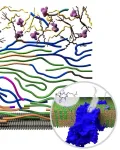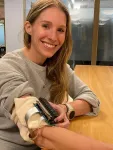(Press-News.org) AUSTIN, Texas — Data from a new investigational drug that could alter the standard treatment for a rare blood disease suggests it has the potential to delay or prevent anemia and the need for intrauterine blood transfusions in babies who are at high risk for the condition, known as Hemolytic Disease of the Fetus and Newborn (HDFN). Results of the Phase 2 clinical trial of the drug nipocalimab were published today in The New England Journal of Medicine.
HDFN is a serious condition in which the blood types of the mother and her fetus do not match, potentially causing life-threatening anemia in the baby. The current standard for treating HDFN requires an average of four ultrasound-guided intrauterine blood transfusions during the pregnancy. Complications with transfusion include fetal death, premature rupture of membranes and preterm birth.
“If further studies support using nipocalimab to treat HDFN, it will make treating the fetus in these pregnancies safer and easier for pregnant moms,” said maternal fetal medicine specialist and lead study investigator Kenneth Moise Jr., M.D. Moise is a professor in the Department of Women’s Health at Dell Medical School at The University of Texas at Austin and co-director of the Comprehensive Fetal Care Center, a clinical partnership between Dell Children’s Medical Center and UT Health Austin, the clinical practice of Dell Med.
Called the UNITY study, the research involved following 13 pregnant women who had either experienced a fetal loss or needed early intrauterine transfusions during a previous pregnancy due to HDFN. DNA tests indicated their current fetus was at high risk of also having HDFN. Participants received intravenous nipocalimab between 14 and 35 weeks of gestation during pregnancy.
More than half the participants in the study (54%) had a live birth at or after 32 weeks without needing a transfusion. Some did not need a transfusion even after birth. None of the babies developed a dangerous HDFN condition called fetal hydrops, a condition linked to a lower survival rate for babies wherein large amounts of fluid collect inside the fetus.
For HDFN, nipocalimab works by halting the transfer of antibodies across the placenta, preventing the attack on the fetus’s red blood cells and lowering the amount of antibodies in the mother’s bloodstream.
“Nipocalimab is the only drug in development with the potential to treat a variety of alloimmune diseases that affect the fetus such as fetal/neonatal alloimmune thrombocytopenia and immune-mediated congenital heart block,” Moise said. Nipocalimab also has the potential to treat a wide spectrum of autoantibody diseases such rheumatoid arthritis and myasthenia gravis, he said.
In late 2023, Johnson & Johnson, the sponsor of the UNITY Phase 2 study, initiated a Phase 3 pivotal trial of nipocalimab in HDFN called AZALEA. Researchers began enrolling pregnant individuals earlier this year who are at risk for severe HDFN and have experienced the condition in a prior pregnancy to further assess the efficacy and safety of nipocalimab. The AZALEA trial is a randomized controlled trial that is being conducted in maternal fetal centers around the world. Moise is the lead investigator of the Phase 3 trial in Central Texas.
END
Drug trial for rare fetal blood disease shows promise for less invasive approach
2024-08-07
ELSE PRESS RELEASES FROM THIS DATE:
Forever chemical pollution can now be tracked
2024-08-07
Organofluorine compounds — sometimes called ‘forever chemicals’ — are increasingly turning up in our drinking water, oceans and even human blood, posing a potential threat to the environment and human health.
Now, researchers at The University of Texas at Austin have developed a way to fingerprint them, which could help authorities trace them to their source when they end up in aquifers, waterways or soil.
The technique involves passing samples through a strong magnetic field then reading the burst of radio waves their atoms emit. This reveals ...
How fungi elude antifungal treatments
2024-08-07
Every year, life-threating invasive fungal infections afflict more than 2 million individuals globally. Mortality rates for these infections are high, even when patients receive treatment.
Aspergillus fumigatus, the most frequent cause of invasive fungal infection in people with suppressed immune systems, is responsible for approximately 100,000 deaths annually around the world. Poor treatment outcomes result from therapeutic failures and the fungi’s resistance to existing drugs.
A new multi-institutional study led by researchers at Michigan State University has characterized how fungi adapt to restructure their cell walls, effectively ...
ACC Asia 2024 explores emerging trends, evidence-based strategies for improving global heart health
2024-08-07
The American College of Cardiology (ACC) and the Cardiological Society of India will host ACC Asia 2024 on August 16-18 in Delhi, India. This conference will bring together all members of the cardiac care team to examine emerging trends and best practices for cardiovascular disease patient care.
“One of the most meaningful outcomes of the annual ACC Asia conference is the ability to communicate with other cardiologists to strategize and innovate new ideas,” said Eugene Yang, MD, MS, FACC, one of the ACC Asia conference co-chairs. “As ...
CalTech team develops first noninvasive method to continually measure true blood pressure
2024-08-07
Solving a decades-old problem, a multidisciplinary team of Caltech researchers has figured out a method to noninvasively and continually measure blood pressure anywhere on the body with next to no disruption to the patient. A device based on the new technique holds the promise to enable better vital-sign monitoring at home, in hospitals, and possibly even in remote locations where resources are limited.
The new patented technique, called resonance sonomanometry, uses sound waves to gently stimulate resonance ...
Using photos or videos, these AI systems can conjure simulations that train robots to function in physical spaces
2024-08-07
Researchers working on large artificial intelligence models like ChatGPT have vast swaths of internet text, photos and videos to train systems. But roboticists training physical machines face barriers: Robot data is expensive, and because there aren’t fleets of robots roaming the world at large, there simply isn’t enough data easily available to make them perform well in dynamic environments, such as people’s homes.
Some researchers have turned to simulations to train robots. Yet even that process, which often involves a graphic designer ...
When is too much knowledge a bad thing?
2024-08-07
CORNELL UNIVERSITY MEDIA RELATIONS OFFICE
FOR RELEASE: August 7, 2024
Kaitlyn Serrao
607-882-1140
kms465@cornell.edu
When is too much knowledge a bad thing?
ITHACA, N.Y. – A new study finds an increase in knowledge could be a bad thing when people use it to act in their own self-interest rather than in the best interests of the larger group.
Cornell University economics professor Kaushik Basu and Jörgen Weibull, professor emeritus at the Stockholm School of Economics, are co-authors ...
Do smells prime our gut to fight off infection?
2024-08-07
Many organisms react to the smell of deadly pathogens by reflexively avoiding them. But a recent study from the University of California, Berkeley, shows that the nematode C. elegans also reacts to the odor of pathogenic bacteria by preparing its intestinal cells to withstand a potential onslaught.
As with humans, nematodes’ guts are a common target of disease-causing bacteria. The nematode reacts by destroying iron-containing organelles called mitochondria, which produce a cell's energy, to protect this critical element from iron-stealing bacteria. Iron is a key catalyst in many enzymatic reactions in cells — in particular, ...
mTORC1 in classical monocytes: Links to human size variation & neuropsychiatric disease
2024-08-07
"This report suggests that a simple assay may allow cost-effective prediction of medication response."
BUFFALO, NY- August 7, 2024 – A new research paper was published in Aging (listed by MEDLINE/PubMed as "Aging (Albany NY)" and "Aging-US" by Web of Science), Volume 16, Issue 14 on July 26, 2024, entitled, “mTORC1 activation in presumed classical monocytes: observed correlation with human size variation and neuropsychiatric disease.”
In this new study, researchers Karl Berner, Naci Oz, Alaattin Kaya, Animesh Acharjee, and Jon Berner ...
In Parkinson’s, dementia may occur less often, or later, than thought
2024-08-07
MINNEAPOLIS – There’s some good news for people with Parkinson’s disease: The risk of developing dementia may be lower than previously thought, or dementia may occur later in the course of the disease than previously reported, according to a study published in the August 7, 2024, online issue of Neurology®, the medical journal of the American Academy of Neurology.
“The development of dementia is feared by people with Parkinson’s, and the combination of both a movement disorder and a cognitive disorder can be devastating to them and their loved ones,” said study author Daniel Weintraub, MD, ...
Impact of drought on drinking water contamination: disparities affecting Latino/a communities
2024-08-07
Long-term exposure to contaminants such as arsenic and nitrate in water is linked to an increased risk of various diseases, including cancers, cardiovascular diseases, developmental disorders and birth defects in infants. In the United States, there is a striking disparity in exposure to contaminants in tap water provided by community water systems (CWSs), with historically marginalized communities at greater risks compared to other populations. Often, CWSs that distribute water with higher contamination levels exist in areas that lack adequate public infrastructure or sociopolitical and financial resources.
In ...





